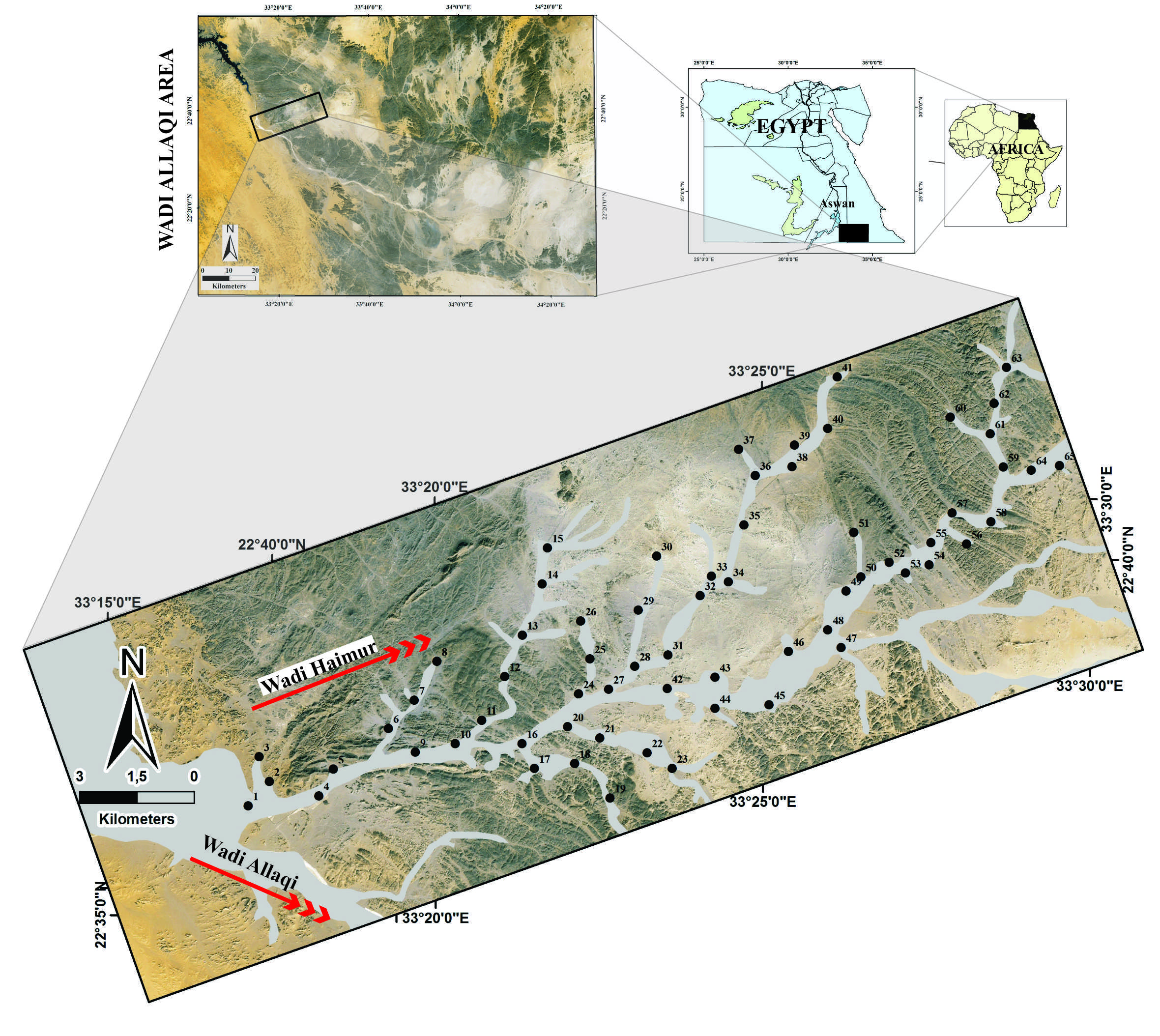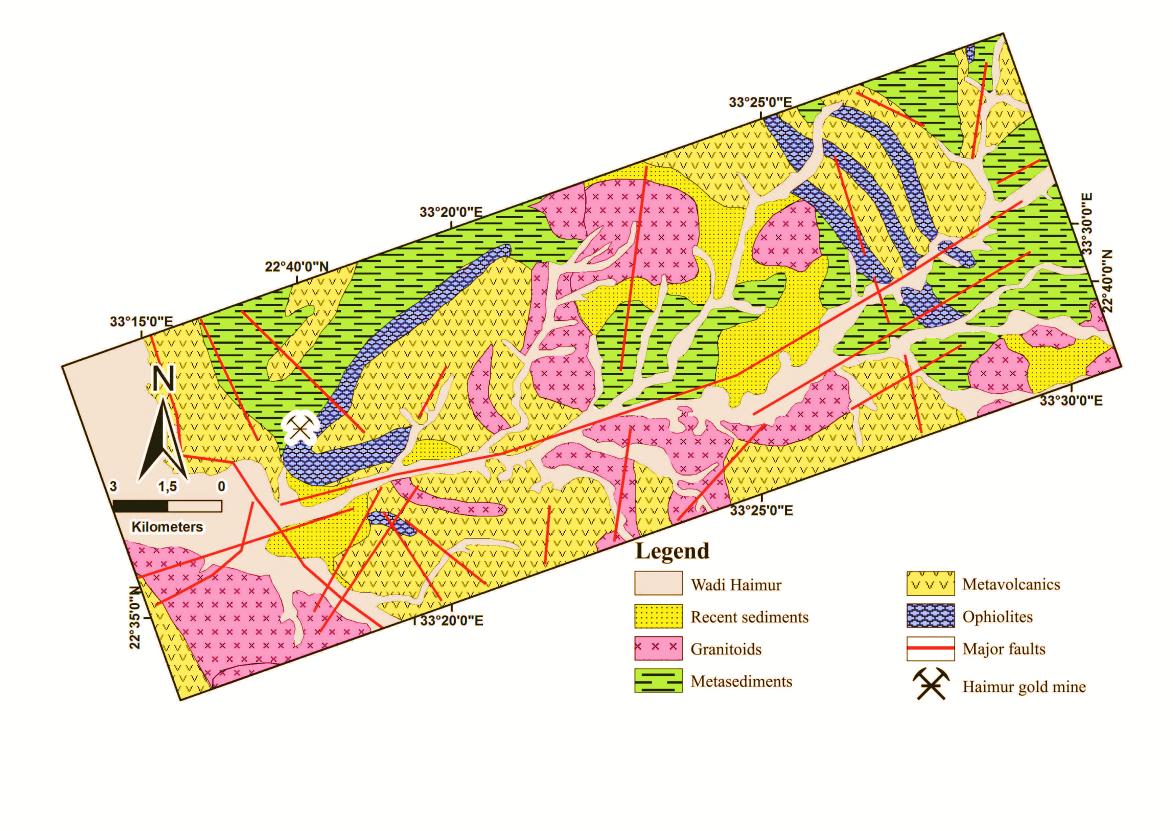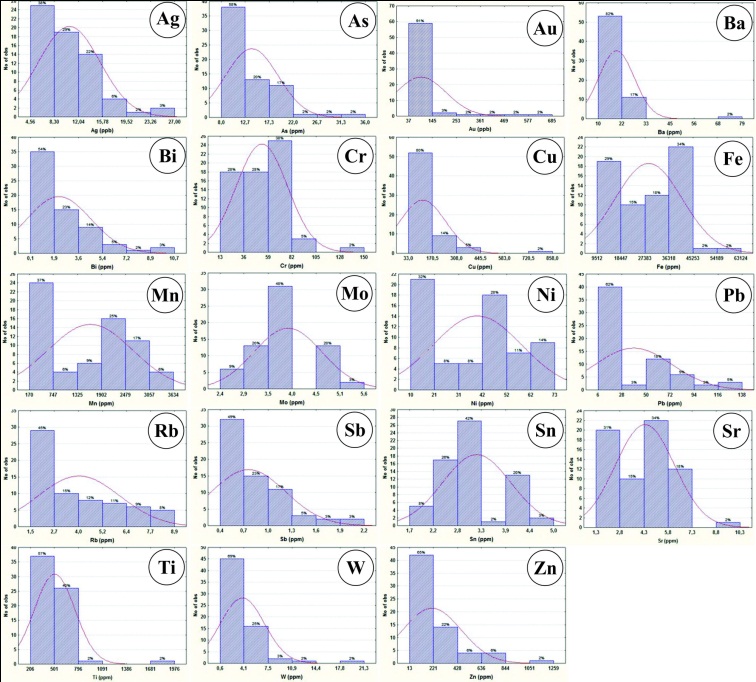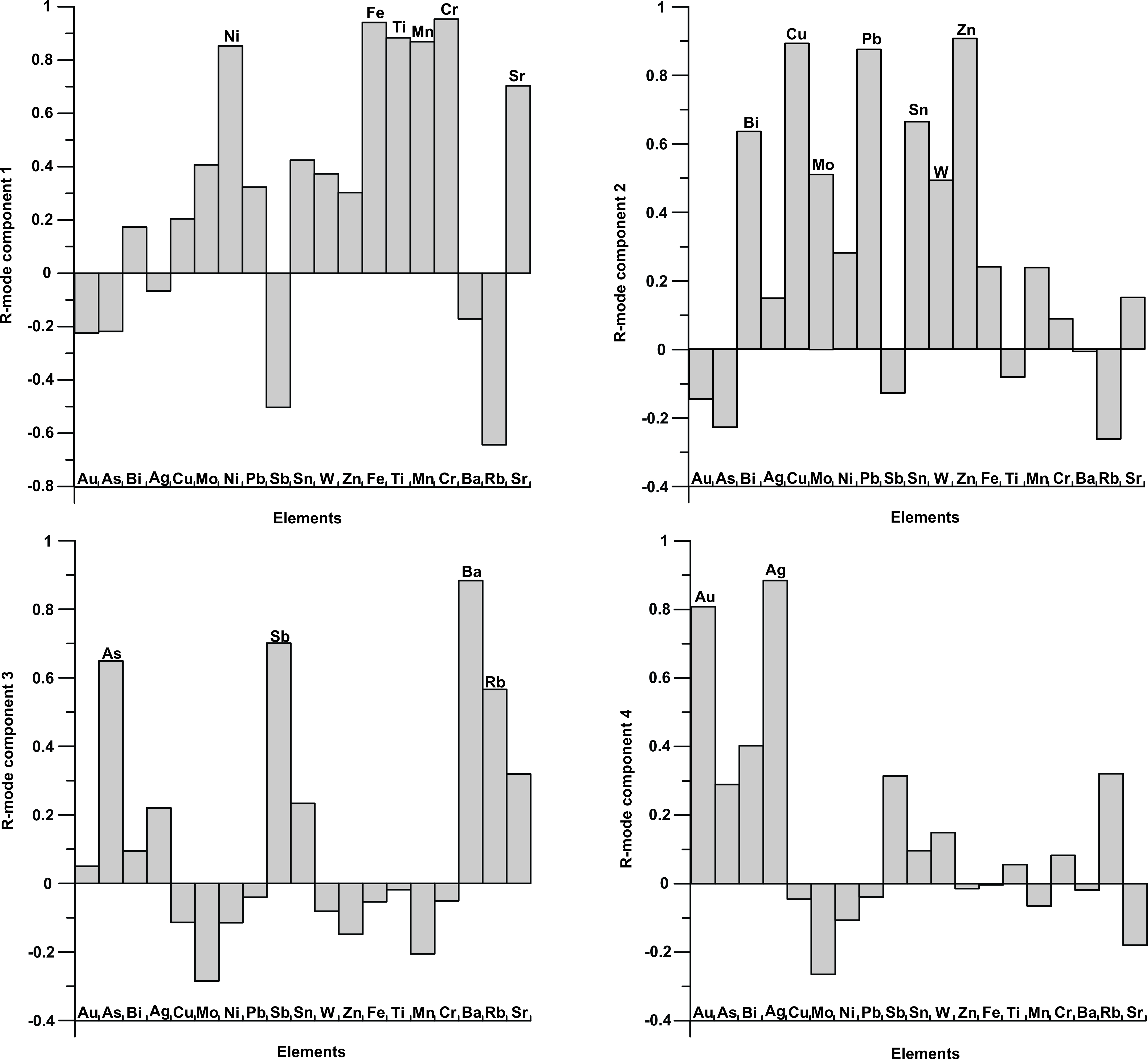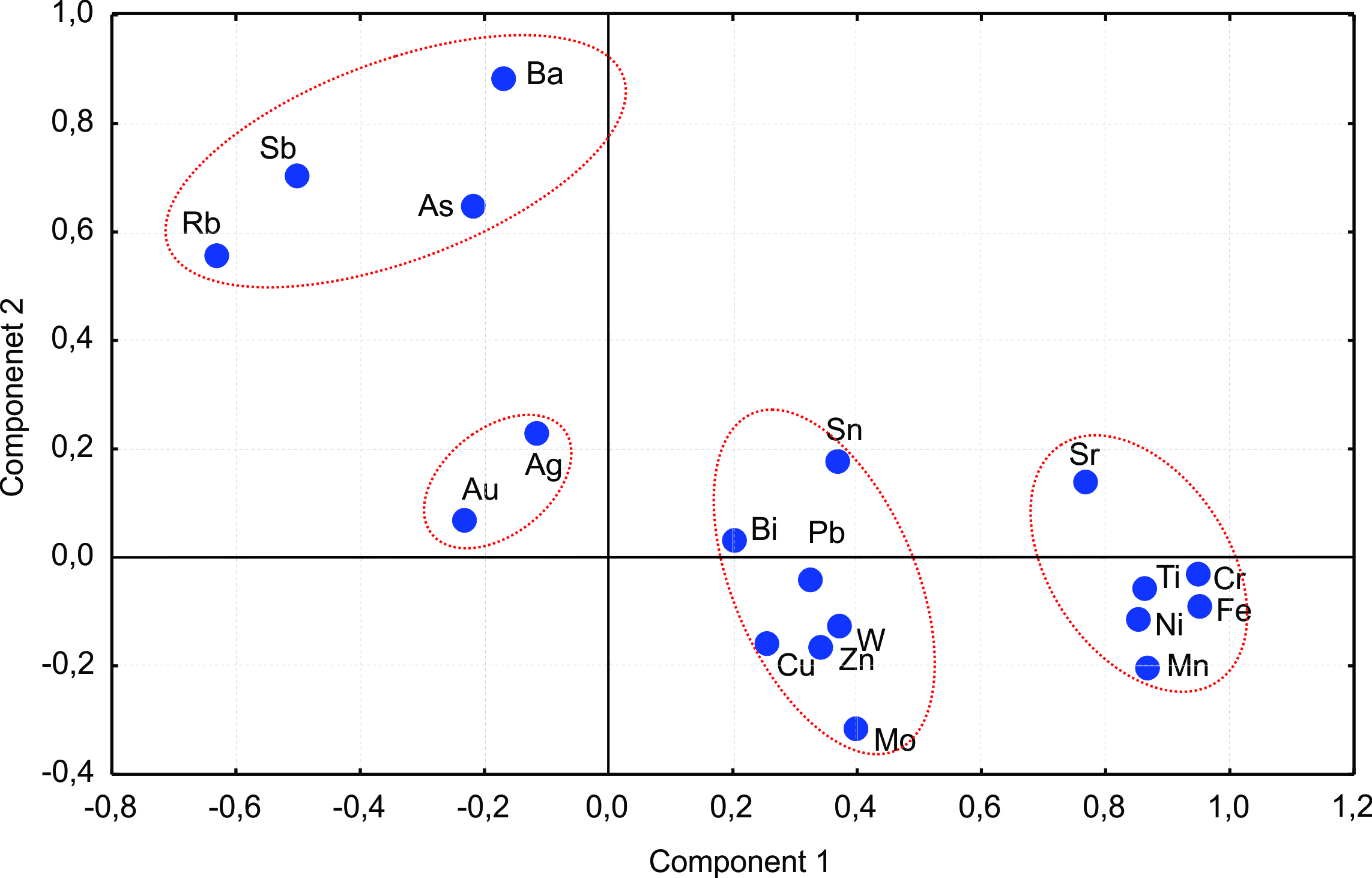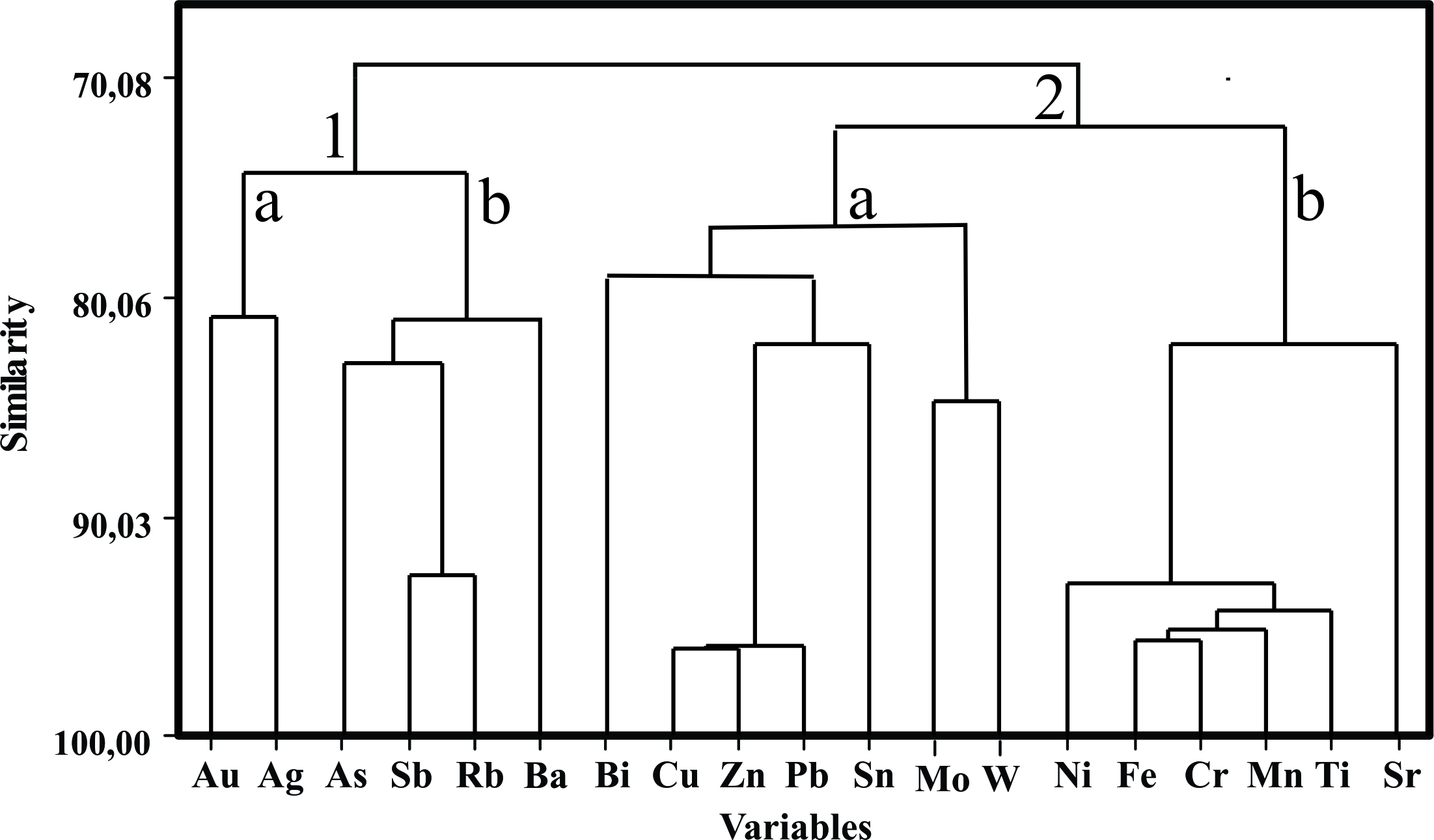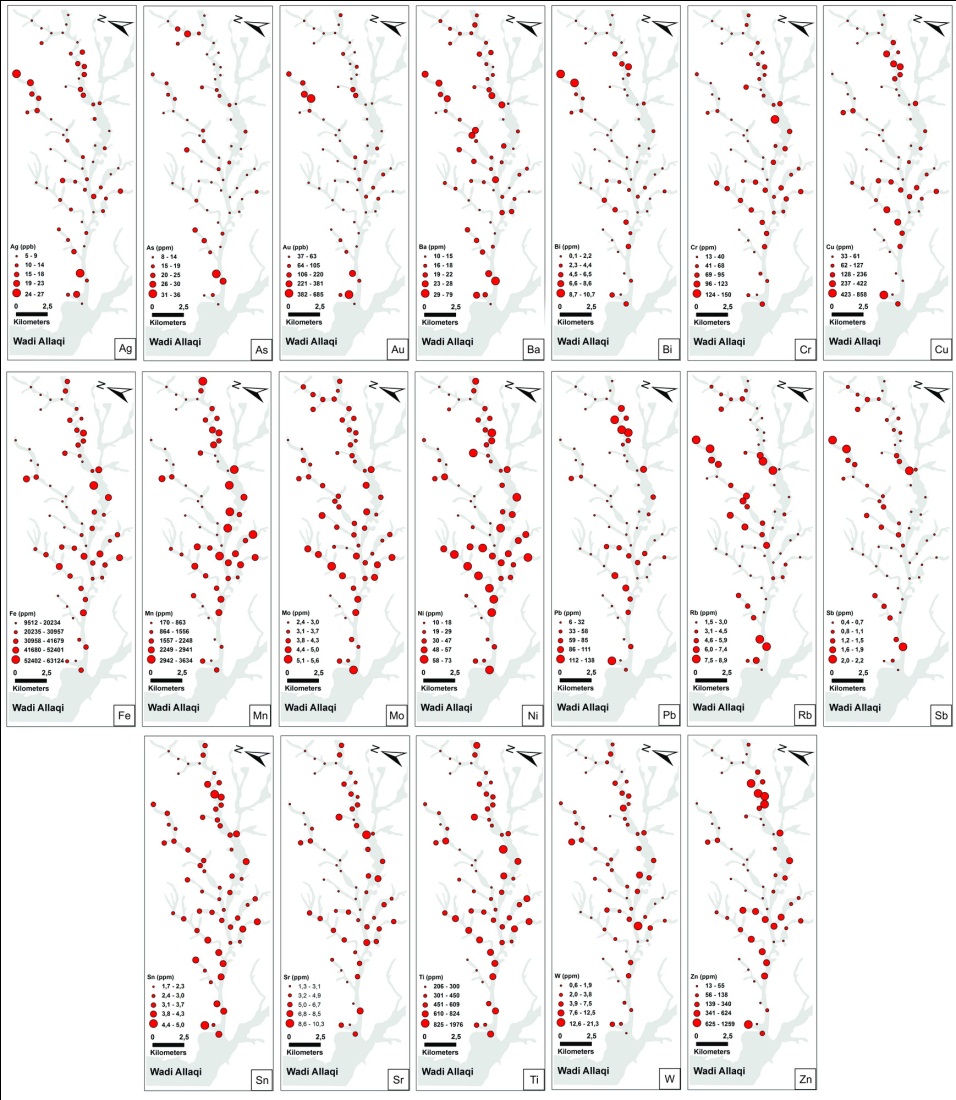A geochemical survey was carried out on the dry stream sediments of Wadi Haimur area, South Eastern Desert of Egypt. These sediments are derived mainly from basement rocks of Late-Proterozoic age. Sixty-five stream sediment samples were analyzed for 19 chemical elements in bulk and four other different fractions after hot extraction with aqua regia. Only results for the bulk fraction were treated with simple and multivariate statistical methods. The correlation between Fe and Mn and most of the analyzed elements suggest the effect of the secondary environment in distribution of certain elements. Also, the multivariate analysis produced four geochemical suits among the analyzed element. In addition, monoelement maps provided for visualization of general distribution of element values. Analyzing and processing of data in the stream sediment samples indicate to presence of new Au-mineralization areas of epithermal and vein type origin. It can be considered that the Ag, As, Sb and Ba are pathfinder elements for the Au in the bulk fraction.
Key words: Stream sediments, bulk fraction, Wadi Haimur, multivariate analysis, Au-mineralization, epithermal
INTRODUCTION
Geochemical surveys these days have become an integral part of mineral exploration particularly in the search for different metallic deposits of Cu, Pb, Zn, Au etc. Stream sediments remain the dominant sampling medium in regional geochemical exploration, in areas where relief permits development of distinct drainage systems [15; 16]. Stream sediments are derived from the weathering of rocks and are dispersed in stream channels. In arid climates, stream sediments can provide good results for prospecting mineral and ore deposits, where the development of anomalies in stream sediments are more stable due to less mobility of certain trace element. Commonly, the stream sediments include unaltered primary minerals, precipitated materials and adsorbed elements [29]. The dispersion of immobile and semi-mobile elements such as Ti, Cr, Mn, Fe, Sn, W and Ba is best studied from stream sediments. The study area is located in Wadi Allaqi district, the southern part of the Eastern Desert of Egypt, about 220 km southeast Aswan city (Fig. 1) which has been a focus of exploration for gold deposits in the last two decades. However, although geochemical surveys form a major part of most companies strategies, little information is available on the geochemical dispersion of elements from deposits and prospects in Wadi Allaqi region especially Wadi Haimur. The study area covers about 270 km2 and drains into Wadi Allaqi. The area is famous for the Haimur Au mine, which is located at the intersection of Latitude 22° 38' 20" N and Longitude 33° 17' 40" E. The region is characterized by an extremely arid environment in which the scarce rainfall usually leads to the formation of rare torrents pouring in the valleys (wadis). The latter are filled with Quaternary poorly alluvium sorted sediments and they are incised in mountainous country comprising igneous-metamorphic basement rocks of essentially Precambrian age. The daily temperature in summer exceeds 45° C and throughout the winter, it is less than 20° C. Vegetation is represented by few shrubs and small trees.
Geologically, the studied area is covered by five distinct unit groups of Late-Proterozoic age including: i) Ophiolite group: this group comprises an association of intensely tectonised and altered basic to ultrabasic rocks dominated by serpentinite peridotite with relic tectonite fabric with calcite; magnesite and asbestos veins and various members of the classic ophiolite suite including cherts, pillow lavas, sheeted dikes, isotopic gabbro and layered gabbro with lesser volumes of meta-basalt and meta-andesite lavas. ii) Metavolcanics: The ophiolites are structurally overlain and partly imbricated with a series of weakly metamorphosed calc-alkaline basic to intermediate volcanics essentially formed of andesite, dacites and volcaniclastics of comparable composition; basalts and rhyodacites are subordinate while the true rhyolites are almost entirely absent [12]. iii) Granitoid rocks which are composed of granodiorite-tonalite rocks and metagabbro-diorite complex rocks; Plutonic rocks related to the island arc association are diorite, tonalite, the plutonic equivalent of island arc andesites and dacite as well as mantle derived gabbro [12]. iv) Metasedimentary rocks: of metapelitic and metapsammo-pelitic rocks. These units are cut by basaltic, andesitic and rhyolitic dykes, quartz veins and veinlets [10]. v) Quaternary deposits of Sand and gravel fill and terraces. The area was subjected to different tectonic deformational phases and traversed by igneous dykes and quartz veins. Major faults in the area running through the main Wadis such as Wadi Allaqi fault which has NW-SE direction and Wadi Haimur fault has a general trend NE-SE to ENE-WSW direction. The main gold mineralization around Haimur old mine is associated with quartz and quartz-carbonate viens and veinlets (striking N55° E and dipping 30° - 60° toward NW) along shear zone and- thrust fault plane [10].
|
Fig. 1. Location map and stream sediment sampling stations in the study area |
Some geological, structural and prospecting studies were conducted there [10, 13, 14, 22].
The main purpose of this paper is to study statistical features and geochemical characteristics of Au and other analyzed elements in bulk fraction of stream sediment samples. In addition to outlining the anomalies of Au, Ag and associated elements, we also determine the pathfinder elements for Au during future detailed geochemical exploration using stream sediment samples in the study area.
|
Fig. 2. Generalized geological map of the study area |
SAMPLING AND ANALYTICAL METHODS
For the geochemical stream sediment survey, sixty-five stream sediment samples were collected from Wadi Haimur (main stream) and its tributaries (fig. 1) using topographic map (scale, 1:50.000). The sample sites were selected based on the nature and type of bedrock and drainage system of the area [26]. Apparently, there is less chance of organic matter concentration in the stream sediments because the study area is nearly barren and has very meager vegetation. The sampling interval was not fixed and being controlled by the drainage system. The resulting sampling density is one sample/4 Km2. A 100 g aliquot of the bulk fraction (<4mm) was milled to <63 µm using a low contamination ring mill with quartz washes between samples to prepare it for chemical analysis. A sub samples (10 g for both gold and silver analysis, and 0.5 g for other elements) of the bulk fraction was subjected to hot aqua regia attack at 95єC in closed system for 1 h, and then determination by Atomic Absorption Spectrophotometry (AAS) in random order.
RESULTS
Descriptive Statistical Evaluation of the Geochemical Data
The descriptive statistical analysis includes: arithmetic mean, median, standard deviation, minimum, maximum, kurtosis and skewness values, are given in Table 1. The obtained data were plotted in the form of frequency distribution diagrams (histograms with their distribution curves) as shown in Fig. (3). Gold has a wide range of concentration (37 to 685 ppb), while Ag has a limited range of concentration (4.6 to 27 ppb). The concentration ranges of the other associated elements are narrow except for Ba, Cu, W and Ti and to some extent As, Bi, Zn and Cr see table.(2). It is clearly noticed that both high value of kurtosis and skewness values in bulk fraction caused a deviation of the raw data far away from the normal distribution and their high values are due to the outlier and extreme values [32]. All of the analyzed elements have non-normal distribution pattern and are positively skewed except Mo (-0.21), Ni (-0.01) and Sn (-0.05). Accordingly, the geochemical data were logarithmically transformed to reduce the asymmetry of the distributions for multivariate analyses.
Descriptive statistics of gold and associated elements studied in stream sediments of Wadi Haimur area (all values in ppm except Au and Ag in ppb)
|
Element |
Mean |
Median |
St.Dev. |
Min. |
Max. |
Kurtosis |
Skewness |
|
Au |
93.00 |
58.00 |
113.00 |
37.00 |
685.00 |
16.00 |
3,90 |
|
As |
14.00 |
12.00 |
5,10 |
8.00 |
36.00 |
5,60 |
2,00 |
|
Bi |
2,20 |
1,20 |
2,30 |
0,12 |
11.00 |
3,50 |
1,80 |
|
Ag |
11.00 |
10.00 |
4,90 |
4,60 |
27.00 |
1,70 |
1,20 |
|
Cu |
114.00 |
54.00 |
130.00 |
33.00 |
858.00 |
17.00 |
3,50 |
|
Mo |
3,90 |
4.00 |
0,76 |
2,40 |
5,60 |
-0,04 |
-0,21 |
|
Ni |
39.00 |
44.00 |
19.00 |
10.00 |
73.00 |
-1,41 |
-0,01 |
|
Pb |
38.00 |
17,80 |
35,20 |
5,60 |
138.00 |
0,17 |
1,10 |
|
SB |
0,74 |
0,75 |
0,49 |
0,37 |
2,20 |
1,80 |
1,50 |
|
Sn |
3,20 |
3,30 |
0,79 |
1,67 |
5.00 |
-0,26 |
-0,05 |
|
W |
3,80 |
3,10 |
3,20 |
0,63 |
21.00 |
14.00 |
3,20 |
|
Zn |
206.00 |
76.00 |
252.00 |
13.00 |
1259.00 |
4.00 |
1,80 |
|
Fe |
28662.00 |
30265.00 |
12465.00 |
9512.00 |
63124.00 |
-0,76 |
0,12 |
|
Ti |
503.00 |
468.00 |
249.00 |
206.00 |
1976.00 |
19.00 |
3,30 |
|
Mn |
1630.00 |
1860.00 |
1020.00 |
170.00 |
3634.00 |
-1,30 |
0,12 |
|
Cr |
53.00 |
55,40 |
25.00 |
13.00 |
150.00 |
2,40 |
0,71 |
|
Ba |
19.00 |
17.00 |
8,50 |
10.00 |
79.00 |
40.00 |
5,70 |
|
Rb |
3,90 |
3,10 |
2,10 |
1,50 |
8,90 |
-0,60 |
0,80 |
|
Sr |
4,40 |
4,80 |
1,80 |
1,30 |
103.00 |
0,08 |
0,36 |
Fig. 3. Frequency distributions of aqua-regia soluble gold and associated elements and their superimposed normal fitting curves based on 65 stream sediment samples from Wadi Haimur.
Correlation Coefficient
Stream sediment samples collected from the investigated area revealed that there are significant positive correlation of Fe with Cr, Cu, Mo, Ni, Pb, Sn, Sr, Ti, W and Zn, also Mn is positively significantly correlated with Cr, Cu, Ni, Pb, Sn, Sr, Ti, W and Zn (Table 2).
Table 2
Matrix of Pearson correlation for stream sediments from Wadi Haimur*
|
|
Au |
As |
Bi |
Ag |
Cu |
Mo |
Ni |
Pb |
Sb |
Sn |
W |
Zn |
Ti |
Cr |
Ba |
Rb |
Sr |
|
Fe |
|
|
|
|
+ |
+ |
+ |
+ |
- |
+ |
+ |
+ |
+ |
+ |
|
- |
+ |
|
Mn |
|
- |
|
|
+ |
|
+ |
+ |
- |
+ |
+ |
+ |
+ |
+ |
- |
- |
+ |
*+ or - above 99% significance level
Multivariate Analysis
It is useful to discriminate between different groups of element contents, which existed in bulk fractions of stream sediment samples after performing the different statistical analyses of geochemical data. The geochemical associations were identified based on PCA analysis (Fig. 4 & 5) and cluster analysis [23, 28, 30] as shown in Fig. (6).
1- Principal Component Analysis (PCA)
Table (3) shows the results of Principal Component Analysis of data. Four significant components with Eigenvalues >1 were obtained and account for about 74.94 % of the total variance were successfully extracted for 19 analyzed elements.
Table 3
Eigenvalues, total variance and cumulative variance percentage extracted from the data set
|
|
Eigenvalue |
% Total - variance |
Cumulative - % |
|
1 |
7,968897 |
41,94156 |
41,94156 |
|
2 |
2,995076 |
15,76356 |
57,70512 |
|
3 |
2,010443 |
10,58128 |
68,28640 |
|
4 |
1,264858 |
6,65715 |
74,94354 |
By taking only factor scores values > 0.5, these components are: Factor 1 has 41.94% of the total variance. It possesses the most important variables including Cr, Fe, Mn, Ni, Sr and Ti. Factor 2 describes 15.76 % of the variance; Cu, Zn, Pb, Sn and Bi are grouped under this factor. Factor 3 includes As, Ba, Rb and Sb explains 10.58 % of the total variance. Finally, factor 4 account for 6.66% of the total variation possesses only Ag and Au (fig. 4).
Fig. 4. R-mode component loadings calculated for 19 chemical elements measured on 65 stream-sediment samples from Wadi Haimur area. Those elements making large relative contributions to the component are indicated. Loadings are given as correlations between elements and the component
Fig. 5. Loadings of the 1st and 2nd R-mode principal components (Equamax raw rotation) for the gold and associated elements through the studied stream sediments.
2-Cluster analysis
The results of elemental associations include two main clusters of variables classifying into 4 groups (subclusters) as following: Group 1 (sub cluster 1a) includes Au and Ag. Group 2 (sub cluster 1b) constitutes As, Sb, Rb and Ba. Group 3 (sub cluster 2a) presents Cu, Zn, Pb, Bi, Mo and W. Group 4 (sub cluster 2b) possesses Fe, Cr, Mn, Ti, Ni and Sr.
Fig. 8. Cluster analysis dendogram for bulk fraction of stream sediment samples in the study area (n=65).
Geochemical Spatial distribution of elements
Figure (7) exhibits the spatial distribution for 19 analyzed elements in the stream sediment samples in the study area. Both of gold and silver higher values appear in two sites close to ophiolites and metavolcanic rocks appear in the stream trending in the NE direction at upstream of Wadi Haimur, and south of the Haimur mine. In addition, a higher concentration of Ba, Bi, Sb and Rb are associated with Au distribution. Some elevated concentrations of Zn, Cu, Pb and Sn are found in upstream sediments of Wadi Haimur drainage.
Fig. 7. Geochemical maps of gold and associated elements in the bulk fraction reflecting the new possible mineralization in the study area.
The significantly positive correlation between each of Fe and Mn with the other analyzed elements (Cr, Cu, Mo, Ni, Pb, Rb, Sb, Sn, Sr, Ti, W, and Zn) indicates that the oxides of both elements played chief role in concentration of such elements. This pointing to these elements may be adsorbed by hydrated Fe- and Mn- oxide grains dispersed in the secondary environment, reflecting that either Fe-/Mn- oxyhydroxides enrich mentioned elements [19], or due to co-precipitation processes of these elements with authigenous Fe- and Mn-oxyhydroxides [2]. The insignificant role of the oxides of both elements in concentrations Ag, As, Au, Ba, Bi and Mo point to the mobile presence of gold-silver granules in oxidized iron oxides after pyrite and arsenopyrite and to the different behavior of both elements during dissolution and transportation processes in secondary environment (4, 5, 8). According to Boyle (1979) in placer gold the expression [1000*Au (Au+Ag)] is mostly greater than 850 and the Au:Ag ratio generally exceeds 1. By applying these equations to our Au and Ag values in bulk fractions we found the results came in harmony with the previous mentioned values (894; 8) respectively. It may indicates the presence of gold nuggets liberated from its original host rock by mechanical weathering processes which prevailing in the study area. In addition, the weakness of Fe and Mn correlation with gold pointing to that, gold exists as free particles supporting that the bulk fraction of the studied stream sediment contain placer gold (gold nuggets). Ba is studied for observing systematic geochemical mobility and dispersion in the arid climatic condition of the study area. Barium is a characteristic element of some Stratiform Sediment-Hosted SSH-type Zn–Pb–Ba deposits. At high temperature, during hydrothermal alteration, Ba becomes mobile, and is deposited after the sulphides as a barite cap [21]. Barium is a powerful indicator of gossan, and so Ba may be used as an indicator for Zn–Pb deposits. Combination of Ba and Mn is also an important tool for discriminating alteration zones because of their low mobility especially in the arid climatic conditions similar to those prevailing in the study area. Naseem et. al. (2002) and Pwa and van Moort (1999) have used Mn-Ba and other indices for geochemical exploration of VHMS in Rosebery, Tasmania. Unfortunately, here Ba shows an insignificant relationships with Mn, Zn and Pb in the examined samples, indicated that Ba could not be used as an indicator of these types of deposits in the bulk fraction during the reconnaissance exploration of the examined study area. Barium anomalies are found in both upstream and downstream sediments where barite occurs filling fractures. However, Ba may be contributed from the altered parts of the ultramafic rocks.
The higher values of Fe, Cr, Mn, Ni and Ti exist along the course of the stream may be an indication of presence of these elements in the mafic and ultramafic rocks of the study area. So that the dispersion trains of analyzed elements in drainage sediments are controlled by their mode of occurrences in the primary environment and mineralization.
It is remarkable that the distribution of Au, Ag, Bi, Ba, Sb and Rb higher values appear in the stream that trending in the NE-SW direction at the west of the mainstream whereas distribution of Zn, Cu, Pb and Sn lie in the upstream drainage of Wadi Haimur. This point to that, these sites are probably derived from a new extension of the mineralized parts trending in the NE-SW to ENE-WSW directions parallel to the prevailed fault directions in the area, the NE-SW thrust fault and ENE-WSW strike fault [10] which including the main Au-mineralization. Whereas those concentration downstream near the old mine may be derived from either the main Au-mineralization or its possible new extension.
Gold was detected in all analyzed samples, indicating that in this extreme arid region, the bulk fraction is suitable for making regional geochemical survey for gold using stream sediments in the area of study.
Geochemical suites
Both the two multivariate statistical analysis methods exhibit four distinct groups among the variables in the study area (Figures 6 and 7) as the following:
Au-Ag suite (Auriferous group)
This suit is designated as auriferous group due to presence of gold particles in some stream sediment samples from the study area [9] in accompanied with Ag which was derived from oxidation of galena mineral associated with gold mineralization [10, 31]. In addition presence of Ag associated with Au in the bulk fraction may be indicate that the Au-mineralization in the study area is epithermal gold-silver vein deposits. It is noticeable that Ag, As and Sb are commonly considered as pathfinder elements associated with Au for this kind of deposits [5, 6; 24].
As-Sb-Rb-Ba suite (Pathfinder group)
This association indicate possibly that these elements might be related to either the mineralization for As and Sb which can considered as a pathfinders for Au deposits or other phases like phyllo-silicates (clays, mica) for Rb and carbonate minerals for Ba, which are the main phases that may trap such migrating elements in the supergene environment where the elements are either sorbed to the solid surfaces or precipitated with secondary minerals (3, 11, 17). Owing to their association with gold in gold deposits leading to their use as pathfinder/indicator elements in gold exploration, arsenic and antimony are considered as important elements. The most common arsenic mineral, globally, is arsenic-bearing pyrite. Arsenic has long been used as an excellent ‘pathfinder element’ because of its low abundance in most rock types and concentration in hydrothermal deposits, as well as its generally low mobility. This, coupled with sensitive analytical protocols by conventional methods, makes the element extremely useful in mineral exploration [6].
Bi-Cu-Mo-Pb-Sn-W-Zn suite (Sulfides group)
these elements point to possible sulfide mineralization in the area. Most of these elements are enriched in Au-bearing deposits, and occurred in accompanying metallic minerals, in native Au or in various other Au minerals [5].
Fe-Cr-Mn-Ti-Ni-Sr suite (Mafic group)
This association indicates the presence of Fe and Mn-oxides, oxy-hydroxides and hydroxides that are commonly present in the crust and the stream sediments [1, 7, 19]. They play an important role in collecting Cr, Ti, Ni, Cu, Pb, Zn, W, Bi, Mo, Sn and Sr either by adsorption or by coprecipitation [1]. Moreover, Fe, Mn, Cr, Ni and Ti themselves are strongly related to the mafic and ultramafic minerals and fragments derived from the surrounding country rocks. dispersed in stream sediments. This can be explained by the control of the geochemical variance by adsorption and co-precipitation of trace elements over ferric oxides and hydroxides
Gold and silver are weak negatively correlated with hydrated Fe- and Mn- oxides in contrast to the other chalcopyrite element and were recorded in new localities in the study area. The presence of Ag associated with Au in bulk fraction indicates the Au-mineralization is the epithermal and vein type origin in the study area. Fe, Cr, Mn, Ni and Ti anomalies in the stream sediments pointing to the mafic rocks to be a source.
Gold data generated for bulk fraction indicate presence of gold placers in bulk fraction of the analyzed samples and useful to make reconnaissance geochemical survey for gold in the study area.
Here it can be considered that the Ag As, Sb and Ba are pathfinder elements for the Au in the bulk fraction during future geochemical survey in the study area.
The authors recommend carrying out detailed lithogeochemical exploration for Au in the newly proposed areas.
-
References:
Avila, P., Santos Oliveira, J.M., Ferreira da Silva, E., Cardoso Fonseca, E., 2005. Geochemical signatures and mechanisms of trace elements dispersion in the area of the Valedas Gatasmine (Northern Portugal). Journal of Geochemical Exploration 85,17–29.
Becker, A., Klock, W., Friese, K., Schreck, P., Treutler, H.Ch., Spettel, B. and Duff, M.C., 2001, Lake SuBer See as a natural sink for heavy metals from copper mining. J. Geochem. Explor., vol. 74(1/3), p. 205-217.
Bhumbla, D.K., Keefer, R.F., 1994. Arsenic mobilisation and bioavailability in soils. In: Nriagu, J.O. (Ed.), Arsenic in the Environment, Part I: Cycling and Characterisation. John Wiley & Sons, New York, pp. 51–82.
Bose, P. and Sharma, A., 2002, Role of iron in controlling speciation and mobilization of arsenic in subsurface environment: Water Researches, vol. 36, p. 4916-4926.
Boyle, R.W., 1979. The geochemistry of gold and its deposits: Geol. Surv. Canada, Bull. 280, 584 pp.
Boyle, R.W., Jonasson, I.R., 1973. The geochemistry of arsenic and its use as an indicator element in geochemical prospecting. Journal of Geochemical Exploration 2, 251–296.
Costa, M.L., Aratijo, E.S., 1996. Application of multi-element geochemistry in Au- phosphate-bearing lateritic crusts for identification of their parent rocks. Journal of Geochemical Exploration 57, 257–272.
Craw, D., 2001, Tectonic controls on gold deposits and their environmental impact, New Zealand: J. Geochem. Explor., vol. 73, p. 43-56.
Dardir, A.A., Soliman, A.A. and El Gamal, E.A., 1989, Prospection for gold in Haimur area, South Eastern Desert, Egypt: Geol. Surv. Egypt, Internal Report 1989/014, 28 p.
Darwish, M.A.G., 2004, Geochemical exploration for the gold in Haimur area, Wadi Allaqi, Southeastern Desert, Egypt: Ph.D. Thesis, Aswan Fac. Sci., South Valley Univ., Egypt.
Edwards, R., Lepp, N.W., Jones, K.C., 1999.Weniger haufig vorkommende Element emit potentieller Bedeutung fur die Umwelt. In: Alloway, B.J.(Ed.), Schwer-metalle in Boden. Springer, Berlin, pp. 332–337.
El Gaby, S.; List, F.K. and Tehrani, R.; 1988: Geology, evoulation and metallogenesis of the Pan-African belt in Egypt. In: El Ghaby, S and Greiling, R. O. (eds). The Pan African belt of NE Africa and adjacent areas. Earth Science and applications. Wiesbaden, Germany, Biewegn, pp.17-68.
Emam, A., 2005, Mineralogical and geochemical studies on some gold deposits and host rocks, Wadi Allaqi, South Eastern Desert, Egypt: Ph.D. Thesis, Aswan Fac. Sci., South Valley Univ., Egypt, 429 pp.
Fawzy, Kh.M., Abdel Rahman, E.M., Madani, A.A., Abdou, M.N. and Emam, A. 2004, Geological, petrographical, geochemical and remote sensing studies on Haimur gold mine area, Wadi Allaqi region, S.E.D., Egypt. J. Egyptian mineralogist.
Fletcher, W.K., 1997. Stream sediment geochemistry in today’s exploration world. In: Gubins, A.G. (Ed.), Proceedings of Exploration ’97-4th Decennial International Conference on Mineral Exploration, pp. 249– 260.
Hale, M., Plant, J.A., 1994. Drainage geochemistry. In: Govett, G.J.S. (Ed.), Handbook of Exploration Geochemistry, vol. 6. Elsevier, Amsterdam.
Hall, G.E.M., MacLaurin, A.I., Garrett, R.G., 1998. Assessment of the 1 M NH4NO3 extraction protocol to identify mobile forms of Cd in soils. Journal of Geochemical Exploration 64 (1–3), 153–159.
Heinrichs, H. and Hermann, A.G., 1990, Praktikum der Analytjschen Geochemie: Springer-Verlag, Berlin-Heidelberg, Deutschland 669 pp.
Holmstrom, H. and Ohlander, B., 2001, Layers rich in Fe- and Mn-oxyhydroxides formed at the tailings-pond water interface, a possible trap for trace metals in flooded mine tailings : J. Geochem. Explor., vol.74 (1/3), p. 189-203.
Levinson, A. A., 1980, Introduction to Exploration Geochemistry (2nd ed.): Applied Publ. Co., Calgary, 924 p.
Liaghat, S., MacLean, H., 1995. Lithogeochemistry of altered rocks at the New Insco VMS deposit, Noranda, Quebec. J. Geochem. Explor. 52, 333– 350.
Madani, A., Abdel Rahman, E., Fawzy, Kh., and Emam, A., 2003, Mapping of the hydrothermal alteration zones at Haimur gold mine area. South Eastern Desert, Egypt, usjng remote sensing techniques: Egy. J. Remote Sensing & Space Sciences, vol. 6, p.47-60.
Massart, D.L., Kaufman, L., 1983. In: Interpretation of analytical data by the use of Cluster Analysis. Wiley, New York.
McQueen KG, 1997, Ore deposits as geochemical targets, CRC for Landscape Evolution and Mineral Exploration, University of Canberra, Australia.
Naseem, S., Sheik, S.A., Qadeerudinm, M. and Shirin, K., 2002, Geochemical stream sediment survey in Winder Valley, Balochistan, Pakistan: J. Geochem. Explor., vol. 76, p. 1-12.
Nichol, I., 1981, Notes for geochemical exploration workshop in connection with UNDP Project, strengthening the GSP. Dept. of Geol. Sci. Queen’s Uni., Kingston., 122 pp.
Pwa, A., van Moort, J.C., 1999. Geochemical exploration using acid insoluble residues of rocks for volcanic-hosted massive sulphide deposits, Rosebery area, western Tasmania. J. Geochem. Explor. 66, 55– 69.
Romero, A.,Gonzalez, I., Galah, E., 2006. Estimation of potential pollution of waste mining dumps at Pen\widetildea del Hierro (Pyrite Belt, SW Spain) as a base for future mitigation actions. Applied Geochemistry 21, 1093–1108.
Rose, A.W., Hawkes, H.E. and Webb, .J.S. (1979) Geochemistry in mineral exploration, 2nd Ed., Academic Press, London. 657 p.
Ward, J.H., 1963. Hierarchical grouping to optimize an objective function. Am. Stat. Ass. J, 236–244.
Yilmaz, H., 2003, Geochemistry exploration for gold in western Turkey: success and failure. J. Geochem. Explor., vol. 80 (1), p. 117-135.
Zhang, C, Manheim, F.T., Hinde, J., Grossman, J.N., 2005. Statistical characterization of a large geochemical database and effect of sample size. Applied Geochemistry 20, 1857–1874.








